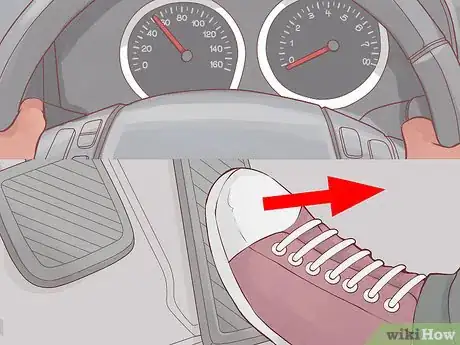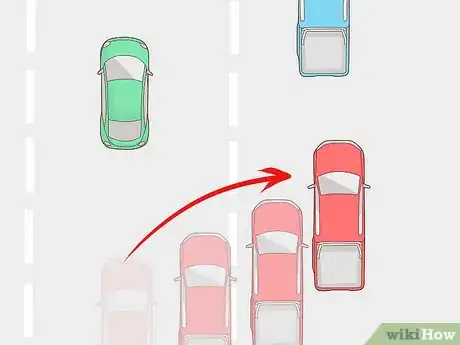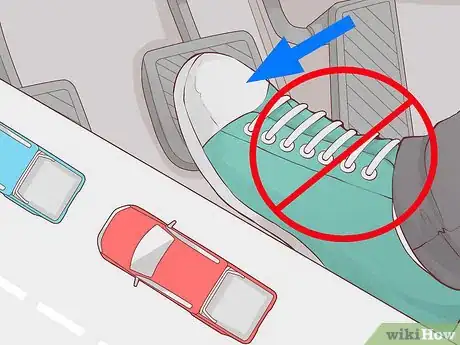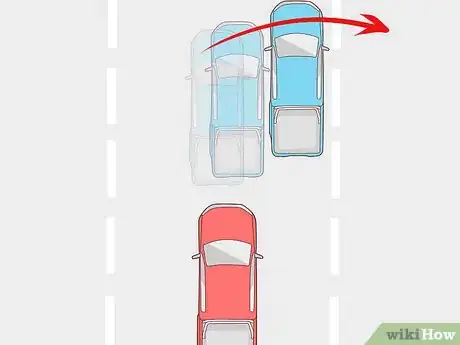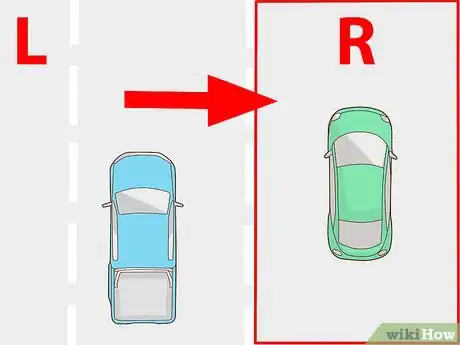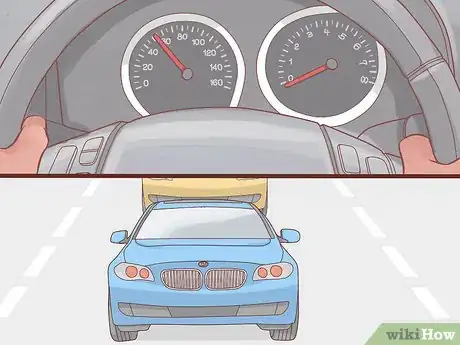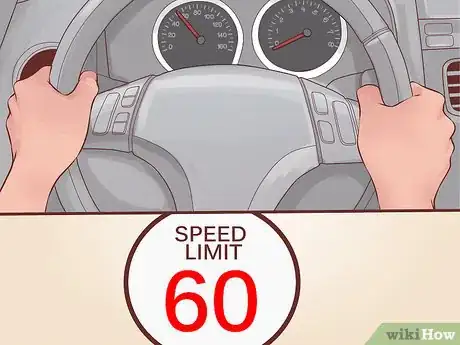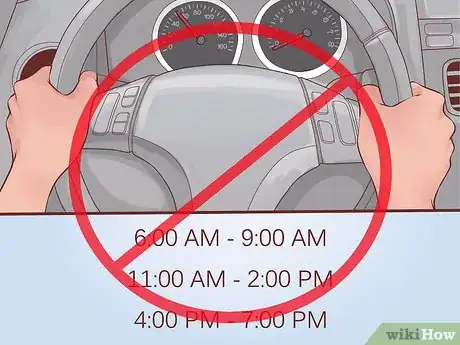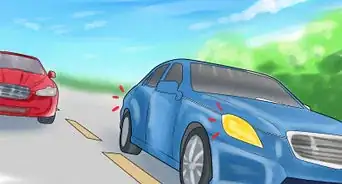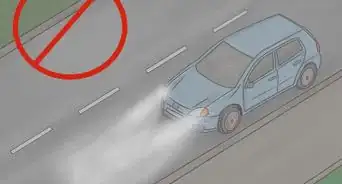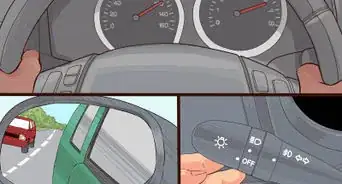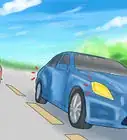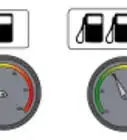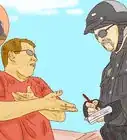This article was co-authored by Ibrahim Onerli. Ibrahim Onerli is a Driving Instructor and the Manager of Revolution Driving School in New York City. His mission is to make the world a better place by teaching safe driving. Ibrahim trains and manages a team of over eight driving instructors. He specializes in teaching defensive driving and stick shift driving.
There are 8 references cited in this article, which can be found at the bottom of the page.
This article has been viewed 50,734 times.
Tailgaters can be an annoying and dangerous hazard on the road. Sometimes they drive up behind you incredibly quickly and catch you off guard. They might honk their horn at you and, if you look in your rearview mirror, it may look as if the person is literally riding on your rear bumper. This can be a perilous situation for you to find yourself in. But if you practice a little defensive driving and stay mindful of your surroundings, you can avoid tailgaters while you’re driving.
Steps
Getting Out of the Way
-
1Slow down gradually. If you are travelling at the speed limit, or going with the flow, slow down slightly and look for the first opportunity to move out of the way of the tailgater so they can pass you safely. The only place where you want a tailgater to be is in front of you. [1]
- If you are on a two-lane road where passing is permissible and you're already going as fast as you are comfortable going, slow down and encourage the tailgater to pass. Waving someone forward to pass you is generally considered acceptable on country roads.
- If you slow down gradually, the tailgater will respond by slowing down as well. This way if something unexpected happens in the road, and the tailgater hits you, the accident will be much less severe because the momentum will be lower and they will hit you with much less force.
-
2Move to an outside lane (not the shoulder) and allow faster traffic to pass. In most places, faster traffic moves in the inner lanes (the "fast lanes") and slower traffic in the outer lanes (the "slow lanes"). Moving to this lane will also give you a chance to pull off onto the shoulder (if one is available) in case you need to pull out of traffic completely.[2]
- However, if you pull off the road and the tailgater does the same, pull back on the road and find a populated area (like a shopping mall or a rest area) to pull off at. People have been robbed because they were hit by a tailgater and pulled off in the middle of nowhere. Always be cautious and safe when pulling off of the roadway.
Advertisement -
3Find alternate routes. If you notice that the route you take to get wherever you're going is a constant source for tailgating or other road rage, it might be safer to find another way to go, not to mention much less stressful.[3]
- Try taking city streets instead of congested highways when possible. Tailgating is more common on busy highway roads and interstates where people can drive at faster speeds.
Avoiding Road Rage
-
1Never pump your brakes at a tailgater. Even though it may seem logical to you to make an attempt to tell the tailgater they are too close to you, don’t do this.[4] The tailgater already knows they’re too close. They just don’t care. If you pump your brakes, the tailgater will become desensitized to your braking and might hit you if you suddenly had to stop.[5]
- Pumping your brakes at a tailgater may also make them angry and cause them to react in a negative or violent way toward you.
-
2Make a turn to get away from the tailgater. If someone is really tailgating you and you feel unsafe, take the first right turn you can. Resume your route when the impatient motorist has passed. Getting out of the way may be the easiest way to get yourself out of the situation and back to safety.[6]
- If you are being followed closely by a vehicle and, when you turn off the road the car still follows you, never drive to your home or any personally identifiable location. Continue onward and drive around the block. Odds are good that it was a mere coincidence, but if the vehicle continues to follow you after several random turns, drive to the nearest police station or contact the police with a cellular phone if you have one available.
-
3Stay in the right-hand lane. If you are not driving faster than most of the cars around you, stay in the right lane at all times. Since the left lane is intended only for passing slower vehicles, cars traveling faster tend to be in the left lane more often. This means that you are more likely to encounter someone tailgating you (and getting angry about your slower speed) if you are driving in the left-hand lane.[7]
- Only use the left lane for passing. Get around the car you’re passing and get back over into the right lane as quickly and safely as possible.
Driving Defensively
-
1Be aware of your surroundings. Watch for changes in road conditions, changes in speed, debris on the road, and the behavior or other drivers on the road. These things can be distracting and often cause accidents, or at least erratic driving, which can incite tailgaters to start following you more closely.[8]
- Pay attention to the items in your car to reduce distractions while driving. If you are distracted by what’s happening inside your car rather than focusing on the road, you will be a less safe driver to those around you.
- Pulling out in front of someone else (especially if they happen to be a habitual tailgater) can be a dangerous mistake. It may upset a tailgater and cause them to act irrationally.
-
2Be mindful of the speed limit. One way to drive defensively and avoid tailgating is to pay close attention to the posted speed limit. Make sure that you are driving with the flow of traffic, but also that you are not going too fast or too slow for the posted speed zone.[9]
- Tailgating accidents often happen when people are driving too slow for the situation (significantly under the posted speed limit or going slower than the flow of traffic).
-
3Signal ahead of time. One way to avoid accidents caused by tailgating is to signal with plenty of advance warning.[10] If you tell a tailgater (by using your blinker) that you intend to change lanes, they will probably avoid zooming around you in the other lane.
- This will help protect you from tailgaters who may come up behind you very quickly.
-
4Avoid rush hour traffic. Try to avoid driving during rush hours – typically 6:00 a.m. to 9:00 a.m. (morning rush), 11:00 a.m. to 2:00 p.m. (lunch rush), and 4:00 p.m. to 7:00 PM (evening rush). Rush hours typically happen during the weekdays. While this may not leave a lot of room to conduct daily business, particularly if you stay at home during the day, these are times when motorists are most often on the roads and in a hurry to get to work (or wherever else they are going) on time.[11]
- Also consider avoiding using highways, interstates, or other high-speed thoroughfares for short trips. Tailgating often happens on roads with high speed limits.
-
5Be more cautious at night. Because of the limited visibility, it is important to be extra vigilant when you are driving at nighttime. Speed limits are often lower at night, so pay attention to that as well.
- Tailgaters are particularly hazardous at night because of the bright headlights and what a distraction this can be while driving at night. If you have a tailgater following too closely at night, try to get away from them and out of their headlights.
-
6Drive carefully in inclement weather. Tailgating is particularly dangerous during poor weather conditions because the roads may not be in the best shape for sudden stops. Always be mindful of road conditions when you are driving.[12]
- If you are driving on icy or slick roads, breaking quickly could cause you to slip and slide and lose control of your vehicle. If a tailgater does this, they probably won’t have enough time to react before hitting you with their car.
Expert Q&A
-
QuestionHow do you prevent someone from tailgating?
 Ibrahim OnerliIbrahim Onerli is a Driving Instructor and the Manager of Revolution Driving School in New York City. His mission is to make the world a better place by teaching safe driving. Ibrahim trains and manages a team of over eight driving instructors. He specializes in teaching defensive driving and stick shift driving.
Ibrahim OnerliIbrahim Onerli is a Driving Instructor and the Manager of Revolution Driving School in New York City. His mission is to make the world a better place by teaching safe driving. Ibrahim trains and manages a team of over eight driving instructors. He specializes in teaching defensive driving and stick shift driving.
Driving Instructor The reality is that you can't. You cannot control other drivers. The best you can do is drive defensively, signal to other drivers, and avoid letting rude people throw you out of your headspace.
The reality is that you can't. You cannot control other drivers. The best you can do is drive defensively, signal to other drivers, and avoid letting rude people throw you out of your headspace. -
QuestionWhat should I do if someone is yelling at me?
 Ibrahim OnerliIbrahim Onerli is a Driving Instructor and the Manager of Revolution Driving School in New York City. His mission is to make the world a better place by teaching safe driving. Ibrahim trains and manages a team of over eight driving instructors. He specializes in teaching defensive driving and stick shift driving.
Ibrahim OnerliIbrahim Onerli is a Driving Instructor and the Manager of Revolution Driving School in New York City. His mission is to make the world a better place by teaching safe driving. Ibrahim trains and manages a team of over eight driving instructors. He specializes in teaching defensive driving and stick shift driving.
Driving Instructor Those kinds of people are just looking for a reaction. If you don't give them one, they'll stop. Just keep your window closed, don't let them bother you, and just ignore it.
Those kinds of people are just looking for a reaction. If you don't give them one, they'll stop. Just keep your window closed, don't let them bother you, and just ignore it.
Warnings
- Do not spray your windshield wiper fluid. The wind will blow it behind you and onto the tailgater's window. This tends to annoy the tailgater and causes an unsafe driving condition.⧼thumbs_response⧽
- Do not make the situation worse by offending the other driver. Shouting, flipping the bird, or making other obscene gestures will probably make the other driver even madder.⧼thumbs_response⧽
- It can be potentially dangerous to wave someone on or otherwise encourage them to pass you. There are several reasons for this, one of them being that if you make a mistake – say, there's a driveway you don't see on the other side of the road that a car is pulling out of and turning right – you may be liable for any accidents.⧼thumbs_response⧽
- It is illegal (or highly discouraged) to slow down while someone is passing you – if another car suddenly approaches, the other driver needs to make their own decision. Don't complicate things by slowing down, because they may also decide to slow down and fall back behind you.⧼thumbs_response⧽
References
- ↑ https://www.drive-safely.net/rear-ended/
- ↑ https://www.geico.com/more/driving/auto/car-safety-insurance/7-ways-to-avoid-road-rage/
- ↑ http://www.allenandallen.com/blog/safe-driving-tailgating.html
- ↑ Ibrahim Onerli. Driving Instructor. Expert Interview. 18 November 2019.
- ↑ http://580kido.com/how-to-avoid-tailgaters-crazy-drivers-and-other-obstacles-on-eagle-road/
- ↑ https://www.geico.com/more/driving/auto/car-safety-insurance/7-ways-to-avoid-road-rage/
- ↑ https://www.dmv.virginia.gov/webdoc/pdf/dmv39d.pdf
- ↑ Ibrahim Onerli. Driving Instructor. Expert Interview. 18 November 2019.
- ↑ https://dmv.ny.gov/about-dmv/chapter-8-defensive-driving
- ↑ Ibrahim Onerli. Driving Instructor. Expert Interview. 18 November 2019.
- ↑ https://safedriving.wordpress.com/2016/10/19/driving-in-rush-hour-isnt-that-bad/
- ↑ Ibrahim Onerli. Driving Instructor. Expert Interview. 18 November 2019.
